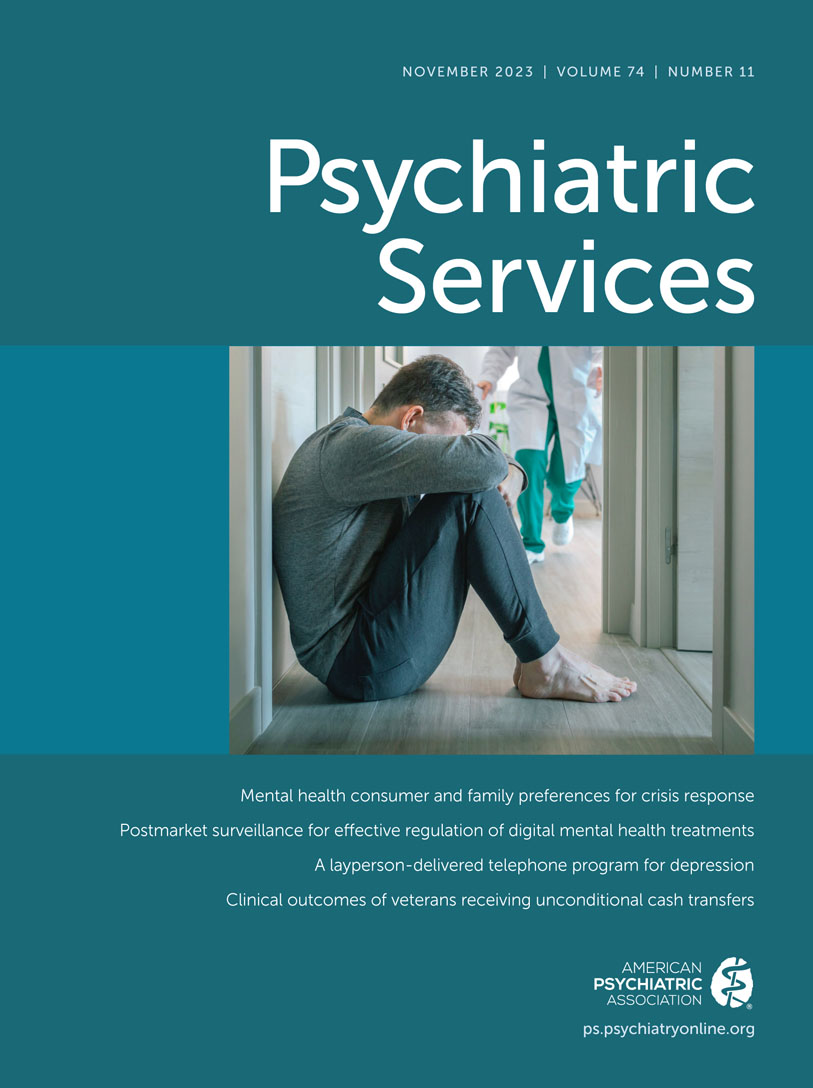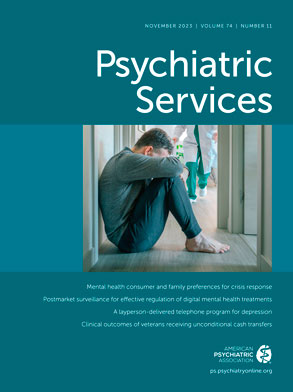A first episode of psychosis (FEP) represents a critical period for prevention. Compared with the general population, people with schizophrenia have more than twice the risk of premature death due to chronic diseases (
1). Social and environmental factors, unhealthy behaviors, and antipsychotic medication–induced weight gain contribute to this risk. Coordinated specialty care (CSC) is a team-based approach that provides multiple evidence-based treatments for youths and young adults with FEP. CSC reduces rates of relapse and hospitalization and improves social, academic, and occupational functioning (
2). Since 2014, a total of 13 states have implemented the NAVIGATE model (
3), based on the Recovery After an Initial Schizophrenia Episode (RAISE) extended treatment program study (
4), including Washington State, which launched the New Journeys program in 2015 (
5).
New Journeys teams lack a standardized approach to monitoring chronic disease risk factors. Nurse care management, a key component of effective integrated care models (such as behavioral health homes) (
6), increases engagement with primary care and improves self-management of chronic diseases in community mental health settings (
7). We developed and pilot tested a nurse care manager role in a network of nine CSC programs in Washington State between July 2019 and October 2021. The project aimed to conduct community-based participatory intervention mapping (
8) to develop and manualize a CSC nurse care manager role and initiate a 6-month implementation phase to explore feasibility and acceptability of the role.
Setting
New Journeys programs serve clients ages 15–40 years who have nonaffective psychosis of ≤2 years duration; 89% of clients are Medicaid enrollees. Each New Journeys team consists of a program director or family education clinician, a psychiatric prescriber, an individual resiliency training therapist, a supported employment and education specialist, a peer specialist, and a case manager. An implementation team from the University of Washington provides training, monthly consultation calls, and ECHO (Extension for Community Healthcare Outcomes) clinics (
5). All nine programs in the network at the start of the project participated in phase 1. Five had been in operation for >2 years, and four were established within the previous 6 months. Four teams had a full client load (30 clients), two had 10–20 clients, and three <10. Three teams had access to a nurse from outpatient services to administer injectable medications; four others had medical assistants for phlebotomy and taking vital signs.
Phase 1
We used community-based participatory research principles and four intervention mapping stages (
8) to tailor the role and workflows to the CSC context. We obtained input from all nine New Journeys teams about current activities, workflows, and barriers to management of chronic disease risk to determine the scope of the management challenges and available resources (stage 1). We conducted semistructured interviews (N=17) with team members (program directors [N=7], psychiatric prescribers [N=4], therapists [N=4], and nurses [N=2]) who supported the teams. Interview audio recordings were transcribed and analyzed with thematic analysis. On the basis of this input and on literature review, we specified targets for the intervention (stage 2). We mapped intervention components onto components of the behavioral health home nurse care manager role (stage 3), and clinical experts and CSC team members identified adaptations to fit the CSC context (stage 4).
One team received support (20% full-time equivalent [FTE] for a nurse) to codevelop a manual for the new role that was based on existing New Journeys manuals. Gaps were identified and addressed by using additional resources. The draft manual was refined through review by end users (a psychiatrist, nurse, and program director) and the University of Washington implementation team to ensure clinical utility and external validity. This iterative process of review and revision continued throughout phase 1 through monthly meetings with the New Journeys team.
Phase 2
A New Journeys team with high-fidelity implementation of the NAVIGATE model and agency commitment to dedicate a 20% FTE nurse from adult outpatient services to the New Journeys team was selected as the implementation team. Between March and September 2021, the team provided care to 28 youths and young adults.
Practice Facilitation and Evaluation
The research team—experts in integrated care (L.A.C.), clinical nursing (S.C.C.), and CSC (M.M.D.)—met monthly with an implementation team from the pilot site (comprising a program director, a nurse, and an administrator). Implementation support meetings tracked progress toward specified goals and addressed implementation barriers identified during the implementation period (
9). For example, we worked with the agency’s information technology department to develop a data-tracking tool within the electronic health record (EHR) and to design a workflow for the nurse to share caseload-level data at weekly team meetings.
Feasibility of the nurse care manager role was based on utilization of nurse services and evaluation of nonbillable activities during the 6-month implementation period. Acceptability was evaluated through semistructured interviews after implementation (N=7) with key stakeholders: a nurse, therapist, and program director as well as two psychiatric prescribers and two clients.
Results
Phase 1
Four main roles of the nurse care manager were identified by CSC teams: health education and coaching, support of medication management, care coordination, and population management (
Table 1). Five themes emerged as anticipated barriers to and facilitators of implementing the nurse care manager role on the team. First, the network’s priority of integrating health and wellness into team activities was a key facilitator. Second, attendance of the nurse care manager at weekly team meetings could contribute to a more holistic view of clients’ health status. Third, a nurse care manager was perceived as very important to support engagement with the psychiatric prescriber and might be especially helpful for adolescents or clients with more severe symptoms. Fourth, many nurses will require training to develop knowledge and skills related to health behaviors among young adults. Finally, all participants identified limited funding or lack of a sustainable financial model as the major barrier to implementation.
Phase 2
The team demonstrated that it was feasible to integrate a nurse care manager who dedicates 1 day per week to the CSC team. The team added a second weekly team meeting focused on health outcomes and medical management. The data-tracking tool was incorporated into nursing and psychiatric provider notes to generate a summary of caseload-level outcomes and process measures that was shared at weekly team meetings.
The nurse cared for 13 of the 28 clients treated by the team during the 6-month pilot, seven of whom had regular clinical visits for health coaching. Statements in interviews suggested that the nurse care manager supported shared decision making, client activation and engagement, and care continuity (
Table 1).
The postimplementation interviews identified challenges with dividing the nurse care manager’s time between New Journeys and other clinical duties. Competing demands reduced the efficiency of the nurse’s work. The pilot agency’s community mental health center that housed the New Journeys implementation team provided nursing cross-coverage for the nurse on days when she was not available to the team. Other nurses provided almost the same number of billable contacts during phase 2 as the dedicated nurse, suggesting that a 20% FTE was insufficient for the nurse role on the team. All seven staff members who were interviewed recommended that the nurse position be at least 50% FTE or that multiple nurses share the workload. Both clients and team members saw value in weekly visits with a nurse for subgroups of clients (e.g., for clients receiving health coaching or for those facing barriers to care engagement) or at specific times in treatment (e.g., after hospitalization). A tool to track clinical outcomes (such as blood pressure, hemoglobin A1c levels, and smoking status) and nurse and psychiatric prescriber appointments was developed for the initial nursing assessment for new clients, but prescribers also began to use it because they found it convenient and efficient for tracking clinical data that could then be summarized in a report created by the nurse.
The primary concern that New Journeys team members had about adding the nurse care manager to the team was the lack of financial sustainability. Many of the activities of the nurse care manager represented time that could not be billed to insurance as clinical care (i.e., were nonbillable hours), including clinical tasks (such as engagement and outreach), program development and implementation tasks, and training and professional development. Across the 6 months of the pilot period, the nurse spent 17%–47% of her 20% FTE on nonbillable activities. The highest amount was during the first month of phase 2, when she dedicated substantial time to planning, developing tools, attending meetings—but even once the workflows were in place, care coordination and data tracking required 25%–33% of the nurse’s time.
Discussion
The findings of this project to codevelop a nurse care manager role provide key lessons for CSC teams. First, clients identified general medical health as an important focus of CSC care, and many engaged in health coaching with a nurse. Second, 20% FTE may be insufficient time for the tasks covered by a nurse care manager on the team. The nurse often attended to care for New Journeys’ clients outside of the dedicated day per week, suggesting creep of this part-time role into her other duties. Nursing tasks for New Journeys clients arose every day, and other nurses covered these tasks on days the dedicated nurse was not available. Third, some care management tasks could be completed by other CSC team members, preserving the nurse care manager’s time for tasks that require nursing expertise. Fourth, a tool in the EHR can track health outcomes and processes and be used to integrate data tracking into the weekly team meeting.
A substantial proportion of the nurse’s time was spent on nonbillable activities, suggesting the need for strategies to cover these costs (e.g., bundled payments that include nursing and health promotion tasks) (
10). Given the national nursing workforce shortage, the role and tasks may need to be adapted for a licensed practical nurse or medical assistant. Future studies should evaluate the impact of the nurse role on CSC teams on outcomes and explore efficient and affordable implementation support strategies.
Some limitations of this study should be acknowledged. The pilot project involved only a single team, and our findings may not be generalizable to other teams in the network or other CSC programs. The availability of a university-based training team to support the state’s CSC teams may also not generalize to all states. Finally, the COVID-19 pandemic significantly affected our ability to report clinical outcomes that occurred during the pilot phase of this project. Like many community mental health providers, the pilot CSC team pivoted to virtual care during the early days of the pandemic, resulting in fewer opportunities to measure general medical health outcomes. The pandemic did highlight the importance of nurse activities on the team, because the nurse led team efforts related to COVID-19 testing and vaccination.
Acknowledgments
The authors acknowledge the financial support from the Washington Health Care Authority and the partnership of the New Journeys programs in Washington State. They also thank the New Journeys programs in Washington State and their partners Christine Curry, M.D., Anna O’Boyle, R.N., Lindsay Solise, R.N., Cammie Perretta, M.S.W., L.I.C.S.W., and Lauren Farmer, L.M.F.T., C.M.H.S.

